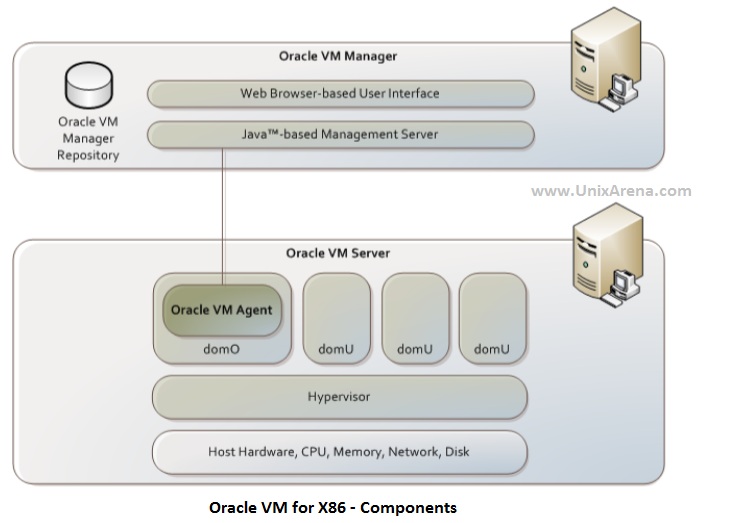UnixArena offers free tutorial on Oracle VM for X86 . Oracle VM is an Oracle’s enterprise virtualization technology for SPARC and X86 hardwares. Oracle VM for SPARC is supported only through Oracle’s T-series servers which is built on SPARC processor(RISC Architecture & only Solaris Guest supported).Oracle VM for X86 is an X86 based hypervisor which is similar to VMware’s vSphere product.Oracle VM for X86 can accommodate various OS guest like, Linux,Solaris, Windows etc. Oracle is highly recommending this product along with Oracle Linux where you want to run oracle databases.
Here is the oracle VM for x86 architecture:

If you follow the below articles in the sequence, you can setup your own OVM environment. Using VMware workstation,you can setup on Laptop/Desktop itself.
1. This the first article about oracle VM for X86 and i just compared this product with VMware vSphere. It will give you good idea about oracle VM if you know VMware .
2.The second article talks about oracle VM for x86 installation. I have captured each and every snapshot of OVM installation and it took two pages to post the article.
3.The third article talks about Oracle VM manager installation. Without OVM manager, you can’t perform any administration tasks on OVM servers.
4.The forth article is all about demonstrating ISCSI storage configuration.
5.The fifth one is all about making the OVM servers pool using OVM manager.
6.The sixth article will help you to create storage repositories on oracle VM serves.
7.To install any guest operating system, you need ISO file of that. So you need copy the ISO file to OVM repository before creating the virtual machine .The seventh article will help you on this .
8.To each VM guest , you need to allocate the network adapter to communicate VM with other servers. Before creating the virtual machine, you need to generate the virtual network adapter and eighth article will help you on that.
9.Once you have completed all the above steps, then you can create a new virtual machine and it explained in ninth artcile.
10.Unlike VMware vSphere VM’s console, you need better knowledge on OVM to take console of VM. Just go through the tenth article which talks about that.
11. What about the OVM upgrade process ? You need to upgrade the OVM manager prior to upgrading the OVM server. The eleventh article talks about OVM manager upgradation.
12.The last article in this tutorial is Oracle VM server upgrade procedure. Please go through it .
I am sure that this bunch of articles will helpful for freshers who is going to start working on OVM. In near future,oracle VM for x86 will be one of tough competitor for VMware.You can find more setups in big organization since OVM cost is very less.
Share it ! Comment it !! Be Sociable !!!
keerthi says
hello sir, can both oracle VM server and and VM manager can be run on same server..?